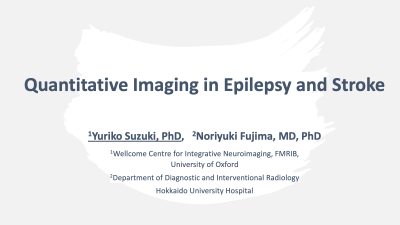Weekend Course
Quantitative Neuroimaging in the Era of Precision Health & Personalized Medicine
ISMRM & ISMRT Annual Meeting & Exhibition • 04-09 May 2024 • Singapore

| 13:00 |
Overview of Quantitative Imaging Techniques I
Mariya Doneva
Keywords: Image acquisition: Quantification This lecture will provide an overview of the basic quantitative MRI techniques employed in neuroimaging. It aims to familiarize the audience with the theoretical principles and practical considerations of using quantitative imaging techniques. Specifically, we will cover methods to estimate longitudinal relaxation time (T1), transverse relaxation time (T2) as well as methods for studying the microstructure such as myelin water fraction imaging and diffusion and quantitative susceptibility mapping (QSM). |
|
| 13:25 |
Overview of Quantitative Imaging Techniques II
Olivier Beuf, Hélène Ratiney, Kevin Tse Ve Koon
Keywords: Image acquisition: Quantification, Neuro: Brain, Image acquisition: Multiparametric In addition to the previous talks, this lecture is devoted to an overview of quantitative MRI methods in neuroimaging in the scope of personalized medicine. Advanced techniques such as MR elastography (MRE), chemical exchange saturation transfer (CEST), magnetic resonance spectroscopy (MRS), arterial spin labeling (ASL), dynamic contrast-enhanced (DCE) imaging, and X-nuclei imaging will be addressed. Measuring tissue stiffness, characterizing tissue content and organization, mapping metabolic state or assessing tissue perfusion are among information MRI can provide today. This comprehensive overview will highlight the potential of quantitative MRI in personalized healthcare for neurological disorders. |
|
| 13:50 |
The Frontiers of Quantitative Imaging
Congyu Liao
Keywords: Contrast mechanisms: Relaxometry, Image acquisition: Multiparametric Quantitative MRI plays an increasingly significant role in clinical and research studies. Recent advancements in accelerated imaging techniques have made quantitative MRI both feasible and accessible within clinically practical timeframes. In this presentation, we will explore several cutting-edge time-resolved multiparametric mapping techniques, such as Magnetic Resonance Fingerprinting (MRF), Echo-planar Time-resolved Imaging (EPTI), and Magnetic Resonance Multitasking. These methods can furnish invaluable insights into various tissue properties, including longitudinal and transversal relaxation times (T1 and T2), transverse magnetization influenced by field inhomogeneity (T2*), proton density (PD), myelin-water fraction (MWF), mean diffusivity (MD), and fractional anisotropy (FA). |
|
| 14:15 |
Quantitative Imaging in Multiple Sclerosis
Cornelia Laule
Keywords: Neuro: Brain, Neuro: White matter, Neuro: Spinal Cord This lecture will provide an overview of quantitative MRI findings in multiple sclerosis (MS) brain and spinal cord. MS clinical features, tissue changes and the need for advanced MRI biomarkers will be reviewed. Results from magnetization transfer, diffusion MRI, quantitative T1, quantitative susceptibility mapping, myelin water imaging, magnetic resonance spectroscopy, and non-proton MRI (23Na, 31P) in MS lesions and normal appearing white/grey matter will be summarized. Clinical translation of advanced MRI techniques through normative atlases will be discussed, as well as challenges such as standardization, reproducibility, and integration with other clinical and biological markers for personalized medicine approaches in MS. |
|
| 14:40 |
Break & Meet the Teachers |
|
| 15:10 |
 |
Quantitative Imaging in Epilepsy & Stroke
Yuriko Suzuki
Keywords: Neuro: Brain, Contrast mechanisms: Perfusion, Image acquisition: Quantification This lecture will provide an overview of the clinical application of quantitative MRI in Epilepsy and Stroke in the scope of precision health and personalized medicine. While we will explore how quantitative MRI can improve diagnosis, prognosis counselling, and defining treatment strategy in addition to conventional MRI images, we will also discuss how the utilities of quantitative MRI can be translated into clinical care and benefit individual patients. |
| 15:35 |
Quantitative Imaging in Brain Tumors
C. Chad Quarles
Keywords: Neuro: Brain, Image acquisition: Quantification, Cross-organ: Cancer At the end of this lecture participants should be able to: 1) describe quantitative neuroimaging methods that are currently used across the spectrum of brain tumor patient care; 2) describe current applications of neuroimaging methods for brain tumor patients, including diagnosis, prognosis, neurosurgical and radiotherapy guidance, and response prediction and assessment, and 3) describe emerging neuroimaging methods and their potential uses in brain tumor patient management. |
|
| 16:00 |
Quantitative Imaging in AD
Michael Zeineh
Keywords: Neuro: Nervous System, Neuro: Brain Connectivity, Neuro: Neurodegeneration Alzheimer’s is a devastating condition afflicting the majority of aging individuals. The need for imaging is to identify early signs of the disease as well as novel markers that detect different aspects of micropathology under active investigation. This talk will review the major and currently investigated aspects of AD pathology along with accompanying advanced imaging modalities that can potentially aid in investigations of disease mechanism and therapeutics as well as clinical translation. |
|
| 16:25 |
Challenges, Unmet Needs, and Future of Quantitative MRI for
Precision Health and Personalized Medicine
Andrew Alexander
Keywords: Neuro: Brain, Transferable skills: Metrology of MRI, Transferable skills: Statistics Neuroimaging for precision health and personalized medicine (PHPM) requires highly precise quantitative imaging measures and large representative and normative datasets. Challenges and unmet needs associated with quantitative MRI for PHPM include sources of measurement variability and errors, measurement standardization, individual brain variation, biological specificity of measures, data processing and analysis complexity, and the cost and accessibility of MRI. Promising new directions include new developments to advanced imaging technologies, open-source MRI sequences, big data, machine learning and point-of-care imaging platforms. These topics will be summarized from the neuroimaging scientist perspective. |
The International Society for Magnetic Resonance in Medicine is accredited by the Accreditation Council for Continuing Medical Education to provide continuing medical education for physicians.